#symphysodon
Text

Brown Discus (Symphysodon aequifasciatus), family Cichlidae, found in the central and eastern Amazon River Basin of South America
photograph by Ivan Alexander Fahler
164 notes
·
View notes
Text

discus fish - full of hearts
35 notes
·
View notes
Photo

#acquariofilia #acquario #acquari #pesce #pesci #ciclide #ciclidi #discus #acquariologia #symphysodon #symphysodondiscus #diskus #acqua #acquariotropicale #aqua #aquarium #sealifeaquarium #aquariums #aquariumday #aquariumhobby #aquariumlife #fish #fishing #fishtank #fishinglife #fishlover https://www.instagram.com/p/Cou5f6doXb_/?igshid=NGJjMDIxMWI=
#acquariofilia#acquario#acquari#pesce#pesci#ciclide#ciclidi#discus#acquariologia#symphysodon#symphysodondiscus#diskus#acqua#acquariotropicale#aqua#aquarium#sealifeaquarium#aquariums#aquariumday#aquariumhobby#aquariumlife#fish#fishing#fishtank#fishinglife#fishlover
3 notes
·
View notes
Text
Wow y'all really like KNY Mermaid AU, huh.

(Giyuu is saved! Thanks to Tanjirou and Kanao stumbling into Shinobu throwing seasoning on Giyuu and persuades her enough to let the poor merman go. Shinobu is salty, Giyuu is bewildered but will take revenge later and then they become friends somehow)
I am thinking of doing mermen Kyojuro and Akaza later (along with Koyuki whom has Akaza tailing her around like a protective puppy) but I am not sure what fish Kyojuro will be based off. I have a few options but if you guys have any ideas, you can comment.
I am thinking of having Akaza's design based off Betta fish cause they're colourful and they're also called Siamese Fighting Fish. (But if you guys have any ideas, comment)
#demon slayer#kny#kimetsu no yaiba#drawing#anime#digital art#akaza#shinobu#giyuu#kamado tanjirō#kanao tsuyuri#giyuu x shinobu#tomioka giyuu#kocho shinobu#kny mermaid au#mermaid#hakuji#akaza x koyuki#hakuji x koyuki#kyoujuro#rengoku kyoujuro
845 notes
·
View notes
Text
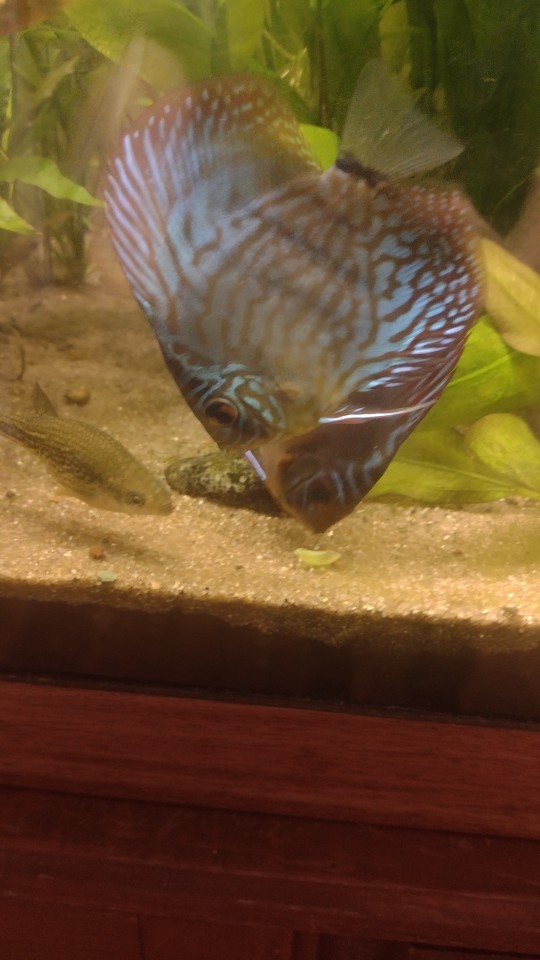
The discus and Ameca splendens enjoying picking apart some peas. It is a myth that they need higher amounts of meat and protein than other cichlids. The common practice of feeding these fish a diet entirely of beef heart and bloodworms will lead to obesity, bloat, and swim bladder disorder. Their intestine length is longer than most other cichlids, indicating that they eat primarily plants and detritus, and dissections of the stomach contents of over 8,500 fish confirm this.
"The alimentary canal of Symphysodon is characterized by a poorly defined stomach and an elongate intestine, some 300 mm long and 3 mm wide (in a 180 mm SL specimen). This intestinal morphology is typical of a cichlid with a dominantly vegetarian, detritivorous, or omnivorous diet. Predominantly piscivorous cichlids such as Cichla and Crenicichla exhibit shorter alimentary canals with well developed stomachs (Zihler, 1982).
Bleher (2006, p. 510-595) reports detailed observational notes on the diet of discus, taken over many years of field visits to the Amazon basin. He undertook stomach content analyses on over 8,500 discus specimens and also made direct observations of feeding in the wild. Although most of his findings are reported qualitatively, Bleher (2006) presents some quantitative data for the volumetric dietary intake of S. haraldi (although numbers of specimens are not given, p. 593). During the high-water period he reports average stomach contents of: 12% algae and microalgae, 44% plant matter (flowers, fruits, seeds, leaves), 6% detritus, 16% aquatic invertebrates, and 22% terrestrial and arboreal arthropods. During the low water period he reports 25% algae and microalgae, 39% detritus, 9% plant matter, 22% aquatic invertebrates, and 5% terrestrial and arboreal arthropods. Data for S. aequifasciatus and S. discus indicate a larger proportion of algae, plant matter and detritus both for during the low and high water periods."
chrome-extension://efaidnbmnnnibpcajpcglclefindmkaj/https://www.scielo.br/j/ni/a/qSgYmZ78qn9yntP9szDDbWC/?format=pdf&lang=en
I feed my discus primarily omega one cichlid flakes, live duckweed, and frozen spirulina + brineshrimp cubes.
9 notes
·
View notes
Text
Varios peces disco de colores.
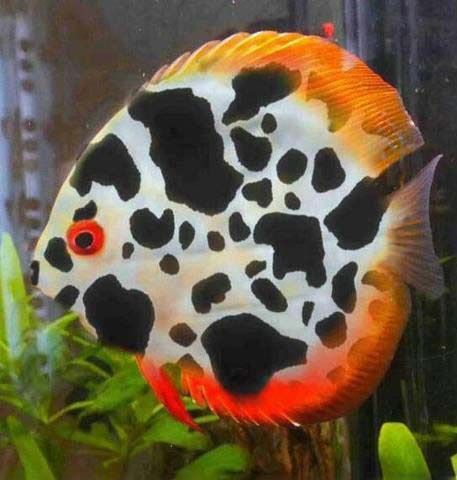
El pez disco (Symphysodon) es un género de pez de la familia de los cíclidos. Es originario de las zonas bajas del río Amazonas y sus afluentes, pertenece a la familia de los cíclidos de origen sudamericano. Son aguas por lo general bastante ácidas y blandas, en lo general con altas concentraciones de taninos derivados de la materia vegetal que queda en contacto con los ríos.
Habita en zonas de aguas lentas, sin fuertes corrientes, pobladas de depredadores como las pirañas, por lo que es un animal asustadizo al que le gustan las zonas con abundante vegetación, que utiliza como refugio.
2 notes
·
View notes
Photo
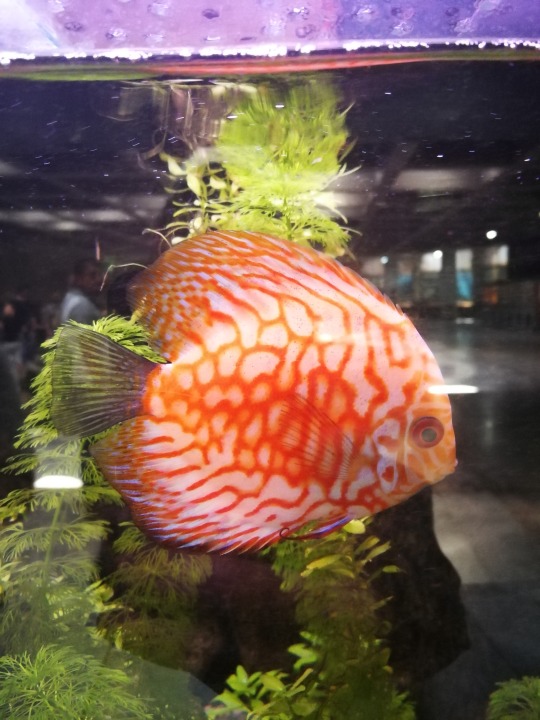
Symphysodon discus
Sofia Zoo, Bulgaria
3 notes
·
View notes
Text
Jenis Ikan Hias Populer.
Terdapat lebih dari 24 jenis ikan hias air tawar yang di budidayakan oleh masyarakat Kabupaten Bogor, namun ada 10 jenis ikan hias yang populer dan paling diminati oleh masyarakat Bogor. Produksi 10 jenis ikan hias ini juga terus meningkat setiap tahunnya. Jenis ikan hias tersebut adalah.
1. Ikan Cupang (Betta sp)

ikan Cupang merupakan ikan yang habitatnya di rawa-rawa dan berada di negara-negara Asia Tenggara salah satunya Indonesia. Ikan ini mudah beradaptasi dengan lingkungannya. Ikan Cupang bisa hidup dalam wadah kecil dengan volume air dan oksigen sedikit. Ikan Cupang selain menjadi ikan hias, sering dijadikan sebagai ikan aduan. Ciri ikan ini secara umum badannya ramping, sisik kecil namun tebal, terdapat cekungan pada ujung badan hingga samping perut. Jenis ikan Cupang yang paling populer dikalangan para hobies di Kabupaten Bogor adalah ikan Cupang Plakat. Cupang Plakat disukai karena keindahannya. Produksi ikan Cupang tahun 2016 di Kabupaten Bogor sebanyak 35.088,53 RE dengan kisaran harga dipasaran Rp. 10.000-15.000,-. Namun untuk jenis-jenis tertentu harganya bisa mencapai Rp. 250.000,-, dilihat dari prospeknya yang bagus, budidaya ikan Cupang memiliki nilai ekonomis yang cukup tinggi.
2. Ikan Koki (Carrasius auratus)

Ikan Koki dipercaya berasal dari negeri china dan berkembang di Jepang. Ikan ini masih satu famili dengan ikan mas, sehingga di masyarakat populer dengan sebutan Mas Koki. Ikan koki memiliki ratusan jenis dengan variasi harga yang berbeda-beda. Kisaran harga ikan Koki yang populer di tingkat pengecer di Kabupaten Bogor adalah kisaran Rp. 7.000 sampai Rp. 10.000. Ikan ini memiliki ciri khas bersirip panjang dan memiliki benjolan di bagian kepala. Semakin indah sirip dan warnanya, harganya semakin mahal. Produksi ikan koki pada tahun 2016 mencapai 27.244,95 RE tersebar di 17 Kecamatan yang ada di Kabupaten Bogor. Daerah yang sangat potensial adalah Parung, Kemang dan Tenjolaya.
3. Ikan Discus (Symphysodon discus)

Ikan Discus memiliki keunikan yang menarik yaitu garis-garis tubuh yang melintang dari ujung kepala sampai ekor. Namun ikan ini memiliki kelemahan yaitu sering stress sehingga ikan ini sering terkena penyakit. Ikan Discus pertama kali ditemukan di Sungai Amazon. Suhu normal yang diperlukan dalam pemeliharaan ikan Discus adalah 27-32°C. Sehingga untuk menjaga suhu nya dibutuhkan beberapa perlengkapan seperti heater untuk menjaga kestabilan suhu dalam aquarium. Produksi Ikan Discus di Kabupaten Bogor pada tahun 2016 mencapai 24.231,46 RE, dengan kisaran harga jual di tingkat pengecer sekitar Rp.50.000-Rp.60.000.
0 notes
Text
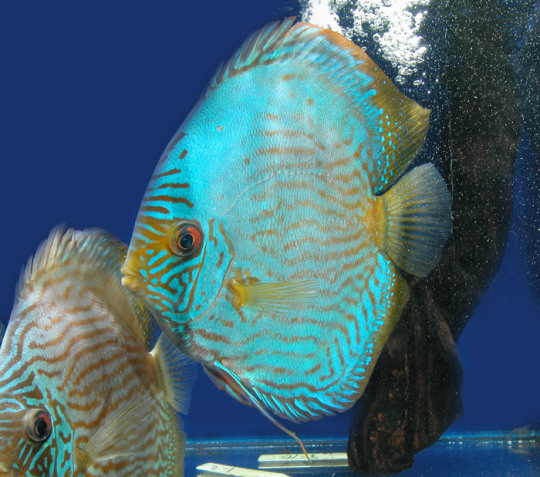
ディスカス(英: discus fish)は、南アメリカのアマゾン川原産の淡水魚で、シクリッド科・シムフィソドン属 Symphysodon に分類される魚である。観賞用熱帯魚として人気がある。
成魚は最大で全長 20 cm、尾ビレを含まない体長は 13 cm ほどになる。体は扁平で非常に体高が高く、横から見るとほぼ円形で、円盤(ディスク)型の体を持つことから、この名がつけられた。背ビレと尻ビレが非常に長く、体の後半部を囲む。体の側面には黒い横帯が8本程度走る。体型・体色には個体/地域差が大きい。一般に赤褐色の地色に、青色から緑色の不規則な筋状の発色がある。原産地では、乾季は倒木の隙間、雨季は水没林に生息し水棲の小動物や動物性・植物性デトリタスを摂餌する。
乾季は倒木の間に群れを形成しグループで生活するが、雨季になるとオスとメスのペアは繁殖のために水没林に移動する。つがいは水草や木の表面などに 50–300 個ほど産卵し、両親で卵を保護する。卵は2.5日ほどで孵化し、さらに稚魚は孵化後7日間かけて卵黄を吸収する。稚魚が両親の周囲を群れて泳ぎはじめると、親魚は体からディスカスミルクと呼ばれる粘液を分泌し、稚魚はこれを摂餌する。泳ぎだしたばかりのディスカスの稚魚はプランクトンなどの餌を摂餌できないのでディスカスミルクは稚魚にとって必要不可欠である。
0 notes
Text
Is there a correlation between fish species and their sensitivity to water changes?

One of the most common concerns among aquarium enthusiasts is the mysterious phenomenon of fish dying after a water change. It is a heart-wrenching experience to find your beloved aquatic pets lifeless shortly after performing what seems like a routine maintenance task. Many aquarium owners often wonder if there is a connection between fish species and their sensitivity to water changes. In this blog post, we will explore this topic and shed light on whether certain fish species are more susceptible to the effects of water changes than others.
Understanding the Impact of Water Changes on Fish
Before delving into the correlation between fish species and water changes, it is essential to grasp the impact of this routine maintenance procedure on aquatic inhabitants. Water changes, if not done correctly, can lead to fluctuations in water parameters, such as temperature, pH levels, and ammonia concentration. Rapid changes in these crucial factors can significantly stress fish, making them more vulnerable to various health issues and even death.
The Science Behind Fish Sensitivity to Water Changes
To determine if fish species play a role in their sensitivity to water changes, researchers have conducted numerous studies. The findings consistently indicate that different fish species possess varying degrees of tolerance to abrupt changes in water conditions. This sensitivity is largely influenced by several biological and ecological factors unique to each species.
To know more about : -
1. Natural Habitat and Environmental Adaptations
Fish species that hail from stable and consistent environments in the wild tend to be less tolerant of abrupt water changes. For instance, species native to slow-flowing rivers or lakes with relatively constant parameters may not cope well with sudden alterations. On the other hand, species accustomed to dynamic habitats with fluctuating water conditions might display higher adaptability to water changes.
2. Biological Resilience
The resilience of fish species also plays a critical role in their reaction to water changes. Some species have more robust physiological systems that can handle minor fluctuations in water parameters, while others may be more delicate, making them susceptible to stress-induced illnesses.
3. Size and Age
The size and age of the fish can impact their susceptibility to water changes. Juvenile fish and smaller species often have less developed physiological systems, making them more vulnerable to environmental disturbances. As they mature, their ability to cope with varying conditions generally improves.
4. Sensory Perception
Fish rely heavily on their sensory organs to interpret their environment. Species with heightened sensory perception may detect and respond to changes more rapidly, allowing them to adjust accordingly. Conversely, species with less acute senses may take longer to adapt, increasing their risk during water changes.
5. Water Change Frequency and Magnitude
The frequency and magnitude of water changes also play a role in fish sensitivity. Regular, small water changes are generally less disruptive to fish compared to infrequent, large-scale changes that lead to significant parameter shifts.
Identifying Sensitive and Resilient Fish Species
Based on available research and aquarium enthusiasts' experiences, some patterns emerge, highlighting fish species that are typically more sensitive to water changes and those that are more resilient:
Sensitive Fish Species:
Discus (Symphysodon spp.): Known for their vibrant colors, Discus fish are highly sensitive to changes in water conditions, especially variations in pH and temperature.
Cardinal Tetra (Paracheirodon axelrodi): Cardinal tetras are delicate and can be adversely affected by sudden fluctuations in water parameters.
Dwarf Gourami (Trichogaster lalius): These colorful and popular fish can suffer from stress-related diseases when subjected to significant water changes.
Resilient Fish Species:
Guppies (Poecilia reticulata): Guppies are hardy and can adapt well to minor fluctuations in water conditions.
Platies (Xiphophorus spp.): Platies are known for their adaptability and can thrive in various aquatic environments.
Zebra Danio (Danio rerio): Zebra danios are robust fish and can handle moderate changes in water conditions.
Conclusion
In conclusion, there is a definite correlation between fish species and their sensitivity to water changes. The natural habitat, biological resilience, size, age, sensory perception, and water change practices all influence a fish species' ability to cope with varying water conditions. As aquarium enthusiasts, it is crucial to research the specific needs of the fish we intend to keep and ensure that water changes are performed carefully to minimize stress and promote a healthy aquatic environment for our beloved finned friends. By understanding these correlations, we can create thriving aquariums that foster the well-being of our aquatic companions for years to come.
Read more : -
0 notes
Link
0 notes
Link
Breeding Discus Fish: A Guide to Creating a Healthy Environment for Mature Breeding Pairs Discus fish, also known as Symphysodon discus, are stunning aquarium fish native to the Amazon River Basin. They are certainly one of the most popular fish species kept by aquarium hobbyists, and many of these hobbyists would like to breed their …
0 notes
Text
Criando con éxito el disco
Criando con éxito el disco
Debido a que los peces disco (Symphysodon) prefieren elegir sus propios compañeros, los acuaristas que esperan criar discos suelen comprar varios especímenes (5-10) a una edad temprana. Cuando se ve que dos peces se emparejan, el otro disco se retira del acuario y tiene un par de apareamiento con el que trabajar. No compre un macho y una hembra en línea y espere que se reproduzcan; te…

View On WordPress
0 notes
Photo
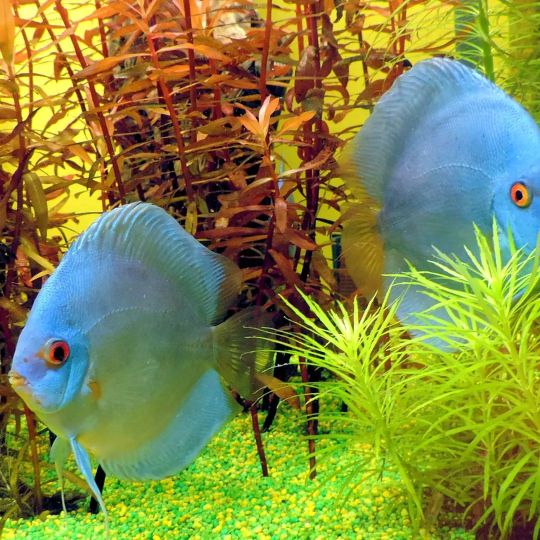
#acquariofilia #acquario #acquari #pesce #pesci #ciclide #ciclidi #discus #acquariologia #symphysodon #symphysodondiscus #diskus #acqua #acquariotropicale #aqua #aquarium #sealifeaquarium #aquariums #aquariumday #aquariumhobby #aquariumlife #fish #fishing #fishtank #fishinglife #fishlover https://www.instagram.com/p/CpXFFmtIW_l/?igshid=NGJjMDIxMWI=
#acquariofilia#acquario#acquari#pesce#pesci#ciclide#ciclidi#discus#acquariologia#symphysodon#symphysodondiscus#diskus#acqua#acquariotropicale#aqua#aquarium#sealifeaquarium#aquariums#aquariumday#aquariumhobby#aquariumlife#fish#fishing#fishtank#fishinglife#fishlover
0 notes
Text
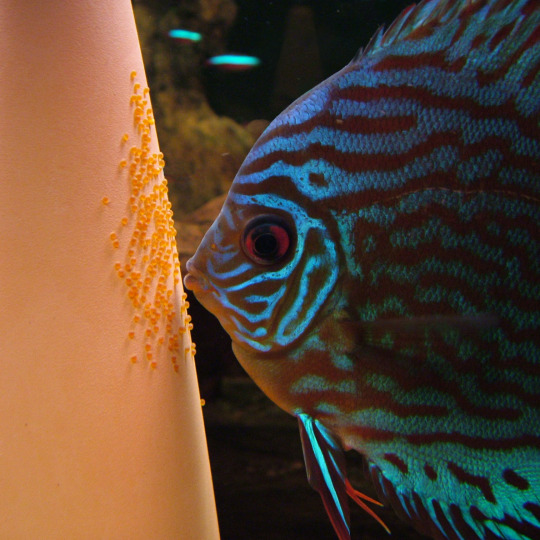
A female Symphysodon aequifasciatus guarding her eggs.
0 notes
Text
Discus fish for sale

That way, you can make sure that your setup is perfect for your new fish before they arrive. Top Tip: Discus is very fussy when it comes to water parameters, so be sure to ask about the water chemistry that your potential purchases were raised in before you buy them. These are tropical fish that need a water temperature of between 82° and 86° F, although wild Heckel Discus prefer very warm water that’s closer to 90° F. Water Parametersĭiscus like soft, acidic water with a pH of between 6.0 and 7.0 and a hardness of between 1 and 4 dKH. A deep aquarium design suits these tall fish best. Tank SizeĪs mentioned above, Discus fish grow to be pretty large, so you’ll need a tank of at least 75 gallons, ideally larger. That said, as long as you provide the fish with a large enough tank, clean water, a high-quality diet, and suitable tank mates, keeping these fish should be no more difficult than caring for any other tropical fish species. Are Discus Fish Easy To Keep?ĭiscus fish are not generally recommended for beginner aquarists, partly because of their large size, semi-aggressive nature, and requirement for pristine water quality. Because of their rather sedate swimming style, Discus fish avoid areas where the current is strong, or too much wave action is present. During the wet season, the fish congregate around fallen trees along the shoreline where the water is quieter. Wild Discus fish come from the flooded forests and floodplain lakes of the Amazon basin and its tributaries, specifically the Rio Negro. Most Discus sold today are captive-bred, hence the wide variety of color variants that are now available in the hobby.ĭiscus fish can grow to measure up to 8 inches in diameter and can live for up to 15 years when given the correct diet. Enthusiasts can get involved in entering their best Discus fish in competitions, shows, alongside many highly skilled and reputable online breeders that use these events to showcase their stock. Red Discus or Heckel Discus ( Symphysodon discus)ĭiscus fish have something of a cult following around the world, which has spawned a multimillion-dollar breeding and dealing industry.Blue or brown Discus ( Symphysodon aequifasciatus).There are at least three recognized species of Discus, all of which belong to the Cichlidae family: 7 Best Places To Buy Discus Fish Onlineĭiscus fish are often referred to as the “Kings of the Aquarium” or Pompadour fish, thanks to their majestic presence in the aquarium and their glorious colors.Can Discus Live In A Community Aquarium?.

1 note
·
View note